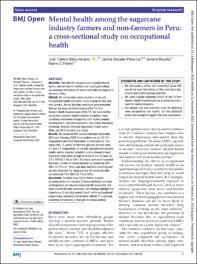Mostrar el registro sencillo del ítem
“Mental health among the sugarcane industry farmers and non-farmers in Peru: a cross-sectional study on occupational health“
| dc.contributor.author | Bazo-Alvarez, Juan Carlos | es_ES |
| dc.contributor.author | Bazalar-Palacios, Janina | es_ES |
| dc.contributor.author | Bazalar, Jahaira | es_ES |
| dc.contributor.author | Flores, Elaine C | es_ES |
| dc.date.accessioned | 2023-02-22T14:40:58Z | |
| dc.date.available | 2023-02-22T14:40:58Z | |
| dc.date.issued | 2022-10-20 | |
| dc.identifier.uri | https://hdl.handle.net/20.500.13053/7864 | |
| dc.description.abstract | “Objective Describe the occupational characteristics of farmer and non-farmer workers and investigate critical occupational risk factors for mental disorders in sugarcane farmers in Peru. Method We conducted a cross-sectional study with occupational health and safety focus among farmers and non-farmers. Mental disorder symptoms were evaluated through the local validated version of the 12-Item General Health Questionnaire (GHQ-12). We explored the association between mental disorder symptoms, work conditions and known occupational risk factors (weekly working hours, pesticide exposures, heat stress and heavy workload). Negative binomial regression models were fitted, and 95% CIs were calculated. Results We assessed 281 workers between December 2019 and February 2020. One hundred and six (37.7%) respondents identified themselves as farmworkers. The mean GHQ-12 scores for farmers and non-farmers were 3.1 and 1.3, respectively. In the fully adjusted multivariable model, mental disorder symptom counts among farmers were more than twice as high as those of non-farmers (β: 2.11; 95%CI: 1.48 to 3.01). The heavy workload increased the mean number of mental disorder symptoms by 68% (95% CI: 21% to 133%), and each additional working hour per day increased the mean number of mental disorder symptoms by 13% (95% CI: 1% to 25%). Conclusion Farmers have higher mental disorder symptoms than non-farmers. A heavy workload and more working hours per day are independently associated with more mental disorder symptoms. Our findings highlight the importance of including mental health within occupational programmes and early interventions tailored to sugarcane industrial mill workers in the Latin American context.“ | es_ES |
| dc.format | application/pdf | es_ES |
| dc.language.iso | eng | es_ES |
| dc.publisher | BMJ Publishing Group | es_ES |
| dc.rights | info:eu-repo/semantics/openAccess | es_ES |
| dc.rights.uri | https://creativecommons.org/licenses/by/4.0/ | es_ES |
| dc.subject | "Mental health, occupational health" | es_ES |
| dc.title | “Mental health among the sugarcane industry farmers and non-farmers in Peru: a cross-sectional study on occupational health“ | es_ES |
| dc.type | info:eu-repo/semantics/article | es_ES |
| dc.identifier.doi | "http://dx.doi.org/10.1136/ bmjopen-2022-064396" | es_ES |
| dc.type.version | info:eu-repo/semantics/publishedVersion | es_ES |
| dc.publisher.country | GB | es_ES |
| dc.subject.ocde | http://purl.org/pe-repo/ocde/ford#3.03.00 | es_ES |
Ficheros en el ítem
Este ítem aparece en la(s) siguiente(s) colección(es)
-
Web of Science (WOS) [236]


